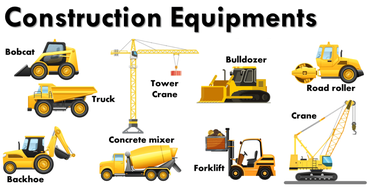Construction projects require a diverse range of machinery and tools to ensure efficiency, safety, and precision. Whether you’re building a skyscraper or a simple home, knowing the types of construction equipment available can help you select the right tools for your job. In this post, we’ll explore various categories of construction equipment, highlighting their functions and applications.
1. Earthmoving Equipment
Earthmoving equipment is essential for moving large amounts of soil, rock, and other materials. This category includes:
- Excavators: Equipped with a bucket and arm, excavators are versatile machines used for digging, trenching, and demolition. They can also be fitted with various attachments, making them suitable for different tasks.
- Bulldozers: Known for their large blades, bulldozers are used for pushing material across a site. They are perfect for grading, leveling, and clearing land.
- Backhoe Loaders: These machines combine a front loader and a rear excavator. They are highly flexible and can be used for digging, lifting, and loading.
2. Construction Vehicles
Construction vehicles are crucial for transporting materials and personnel on-site. Key types include:
- Dump Trucks: Designed for transporting loose materials, dump trucks have a hydraulic bed that can be tilted to unload contents quickly.
- Flatbed Trucks: Ideal for carrying heavy equipment and materials, flatbed trucks provide a stable platform for transport.
- Cranes: These towering machines are used for lifting heavy loads vertically and moving them horizontally. They come in various types, including tower cranes, mobile cranes, and overhead cranes.
3. Compaction Equipment
Compaction equipment is vital for ensuring stable foundations and surfaces. Common types include:
- Rollers: These machines compress soil, asphalt, and other materials to create a solid base. They come in several forms, such as static rollers, vibratory rollers, and pneumatic rollers.
- Plate Compactors: Smaller and more portable, plate compactors are used for compacting granular soils and asphalt. They are particularly useful in confined spaces.
- Tamping Rammer: This equipment is designed for compacting soil in trenches and other tight spots, making it an essential tool for utility work.
4. Material Handling Equipment
Material handling equipment helps in moving and storing materials efficiently. Key types include:
- Forklifts: Widely used in construction and warehousing, forklifts can lift and move heavy loads. They come in various sizes and configurations for different lifting tasks.
- Telehandlers: These versatile machines combine the features of a forklift and an aerial lift. They can extend their reach, making them useful for lifting materials to higher elevations.
- Hoists: Used for lifting heavy objects vertically, hoists are essential in construction for moving materials to upper floors or roofs.
Conclusion
Understanding the different types of construction equipment can greatly enhance project efficiency and safety. Each piece of equipment serves a specific purpose, and choosing the right tools is essential for successful construction operations. Whether you’re a contractor, a project manager, or a DIY enthusiast, being knowledgeable about construction equipment will help you tackle your projects more effectively.
By familiarizing yourself with these tools, you can make informed decisions that will lead to better outcomes in your construction endeavors. Happy building!


Leave a Reply